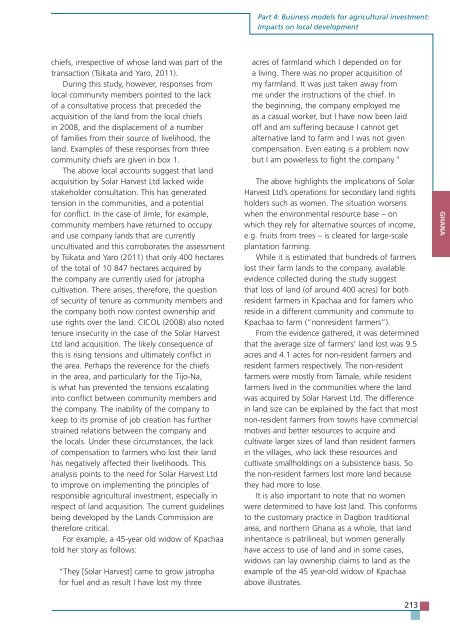TRENDS AND IMPACTS OF FOREIGN INVESTMENT IN DEVELOPING COUNTRY AGRICULTURE
TRENDS AND IMPACTS OF FOREIGN INVESTMENT IN DEVELOPING COUNTRY AGRICULTURE
TRENDS AND IMPACTS OF FOREIGN INVESTMENT IN DEVELOPING COUNTRY AGRICULTURE
You also want an ePaper? Increase the reach of your titles
YUMPU automatically turns print PDFs into web optimized ePapers that Google loves.
chiefs, irrespective of whose land was part of the<br />
transaction (Tsikata and Yaro, 2011).<br />
During this study, however, responses from<br />
local community members pointed to the lack<br />
of a consultative process that preceded the<br />
acquisition of the land from the local chiefs<br />
in 2008, and the displacement of a number<br />
of families from their source of livelihood, the<br />
land. Examples of these responses from three<br />
community chiefs are given in box 1.<br />
The above local accounts suggest that land<br />
acquisition by Solar Harvest Ltd lacked wide<br />
stakeholder consultation. This has generated<br />
tension in the communities, and a potential<br />
for conflict. In the case of Jimle, for example,<br />
community members have returned to occupy<br />
and use company lands that are currently<br />
uncultivated and this corroborates the assessment<br />
by Tsikata and Yaro (2011) that only 400 hectares<br />
of the total of 10 847 hectares acquired by<br />
the company are currently used for jatropha<br />
cultivation. There arises, therefore, the question<br />
of security of tenure as community members and<br />
the company both now contest ownership and<br />
use rights over the land. CICOL (2008) also noted<br />
tenure insecurity in the case of the Solar Harvest<br />
Ltd land acquisition. The likely consequence of<br />
this is rising tensions and ultimately conflict in<br />
the area. Perhaps the reverence for the chiefs<br />
in the area, and particularly for the Tijo-Na,<br />
is what has prevented the tensions escalating<br />
into conflict between community members and<br />
the company. The inability of the company to<br />
keep to its promise of job creation has further<br />
strained relations between the company and<br />
the locals. Under these circumstances, the lack<br />
of compensation to farmers who lost their land<br />
has negatively affected their livelihoods. This<br />
analysis points to the need for Solar Harvest Ltd<br />
to improve on implementing the principles of<br />
responsible agricultural investment, especially in<br />
respect of land acquisition. The current guidelines<br />
being developed by the Lands Commission are<br />
therefore critical.<br />
For example, a 45-year old widow of Kpachaa<br />
told her story as follows:<br />
“They [Solar Harvest] came to grow jatropha<br />
for fuel and as result I have lost my three<br />
Part 4: Business models for agricultural investment:<br />
Impacts on local development<br />
acres of farmland which I depended on for<br />
a living. There was no proper acquisition of<br />
my farmland. It was just taken away from<br />
me under the instructions of the chief. In<br />
the beginning, the company employed me<br />
as a casual worker, but I have now been laid<br />
off and am suffering because I cannot get<br />
alternative land to farm and I was not given<br />
compensation. Even eating is a problem now<br />
but I am powerless to fight the company.”<br />
The above highlights the implications of Solar<br />
Harvest Ltd’s operations for secondary land rights<br />
holders such as women. The situation worsens<br />
when the environmental resource base – on<br />
which they rely for alternative sources of income,<br />
e.g. fruits from trees – is cleared for large-scale<br />
plantation farming.<br />
While it is estimated that hundreds of farmers<br />
lost their farm lands to the company, available<br />
evidence collected during the study suggest<br />
that loss of land (of around 400 acres) for both<br />
resident farmers in Kpachaa and for famers who<br />
reside in a different community and commute to<br />
Kpachaa to farm (“nonresident farmers”).<br />
From the evidence gathered, it was determined<br />
that the average size of farmers’ land lost was 9.5<br />
acres and 4.1 acres for non-resident farmers and<br />
resident farmers respectively. The non-resident<br />
farmers were mostly from Tamale, while resident<br />
farmers lived in the communities where the land<br />
was acquired by Solar Harvest Ltd. The difference<br />
in land size can be explained by the fact that most<br />
non-resident farmers from towns have commercial<br />
motives and better resources to acquire and<br />
cultivate larger sizes of land than resident farmers<br />
in the villages, who lack these resources and<br />
cultivate smallholdings on a subsistence basis. So<br />
the non-resident farmers lost more land because<br />
they had more to lose.<br />
It is also important to note that no women<br />
were determined to have lost land. This conforms<br />
to the customary practice in Dagbon traditional<br />
area, and northern Ghana as a whole, that land<br />
inheritance is patrilineal, but women generally<br />
have access to use of land and in some cases,<br />
widows can lay ownership claims to land as the<br />
example of the 45 year-old widow of Kpachaa<br />
above illustrates.<br />
213<br />
GHANA


